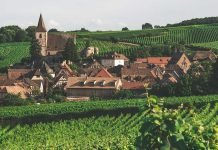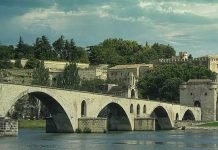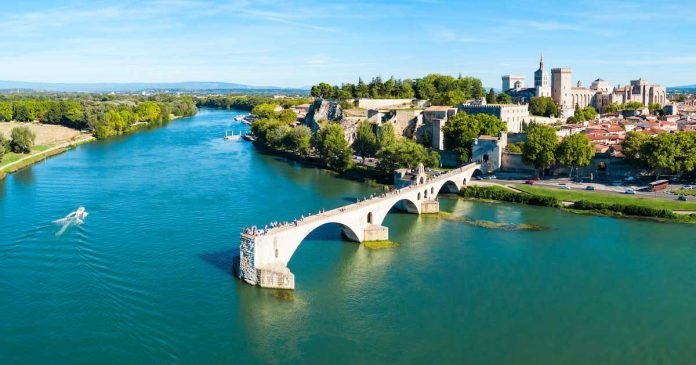Located in the heart of southern France, Avignon is a city that effortlessly bridges the span of centuries, remaining just as alluring now as it was in its medieval heyday. This UNESCO World Heritage city, once the home of popes and a capital of Christendom during the 14th century, today stands as a testament to the indelible spirit and timeless beauty of French history. Avignon is not merely a historic city but a living, breathing storybook. The impressive Palais des Papes, the romantic Pont d’Avignon, and the gastronomic delights of Provencal cuisine are just the beginning of what this vibrant city has to offer. Whether you’re a history buff, a food lover, or someone simply looking for a picturesque escape, Avignon welcomes you with open arms, inviting you to become a part of its rich and storied past.
A Glimpse into Papal Life: The Palais des Papes
Exploring the many rooms of the Palais des Papes (Palace of the Popes), from the grand audience halls to the private papal apartments, is akin to stepping back in time. Every stone and mural tells a tale of spiritual power and grandeur, offering insight into the lives of the nine popes who called this palace home. This UNESCO World Heritage site is one of the most important Gothic buildings in Europe. Don’t miss the intricately painted private chapels and the Grand Tinel, where banquets were held.
A Stroll on the Pont d’Avignon
Just a short walk from the palace, Avignon’s medieval charm continues on the Pont d’Avignon or Pont Saint-Bénezet. This iconic bridge, partially standing as a beautiful ruin, once stretched across the Rhône River. Its tale of a young shepherd inspired by divine visions to build the bridge is enchanting and fits seamlessly into Avignon’s historical narrative.
While the bridge may not be intact, its remaining arches have inspired a popular folk song, “Sur le Pont d’Avignon,” where people are described as merrily dancing in a line. Try a dance step or two, and let yourself be swept up in the city’s magic.
Exploring the Ramparts and Rocher des Doms
Encircling Avignon are the city’s impeccably preserved medieval ramparts, running 4.3 kilometers long. A stroll along these ancient fortifications offers an unbroken glimpse into the city’s past defense mechanisms, as well as breath-taking views of the surrounding landscapes.
Above the city, the Rocher des Doms provides a serene oasis. This verdant park, set atop a rocky outcrop, offers panoramic views of Avignon, the Rhône River, and the neighboring region of Provence. It’s the perfect spot to soak in the city’s timeless beauty as the sun sets, painting the sky in hues of gold and crimson.
Culinary Delights of Avignon
The exploration of Avignon extends to the palate, as the city is steeped in the culinary traditions of Provence. The region’s fertile land, abundant sunshine, and coastal influences are reflected in its flavorful cuisine. Here is a guide to some of the delectable dishes and where you can savor them:
- Daube Provençale: This is a traditional Provençal stew made with tender chunks of beef braised in red wine, garlic, onions, and herbes de Provence. It’s the epitome of comfort food and a staple in local households.
- Ratatouille: A beloved dish made with stewed vegetables like tomatoes, zucchini, onions, bell peppers, and eggplant, usually seasoned with a mix of fresh Provençal herbs.
- Tapenade: This is a piquant olive and caper spread that is typically served on small slices of toasted bread. It is a popular appetizer in Avignon and throughout Provence.
- Tian Provençal: This is a baked dish, a sort of gratin, usually composed of layered eggplant, tomatoes, and zucchini, seasoned with herbs and sprinkled with cheese.
- Dining Establishments:
- La Fourchette: This restaurant, located in a charming part of Avignon, offers a mix of traditional and innovative Provençal cuisine, with a focus on seasonal and local products.
- Le Petit Palais: Not to be confused with the museum, this dining spot is known for its cozy atmosphere and classic Provençal dishes.
- Local Markets: For a true taste of Avignon, visit Les Halles, the city’s vibrant covered market. Here, you can find everything from freshly baked bread and pastries to local cheeses, olives, and an array of Provençal fruits and vegetables.
Wine Tasting in the Rhône Valley
Your gastronomic journey wouldn’t be complete without sampling the regional wines. As a Francophile, indulge in wine tasting tours of the Rhône Valley, one of the oldest and most distinguished wine-producing regions in France. Here is a guide to some of the wines and where you can taste them:
- Châteauneuf-du-Pape: Perhaps the most famous wine of the Rhône Valley, Châteauneuf-du-Pape is known for its robust, full-bodied reds made primarily from Grenache, Syrah, and Mourvèdre grapes. The village of Châteauneuf-du-Pape, a short drive from Avignon, is dotted with cellars offering tastings.
- Côtes du Rhône: This is a catch-all wine appellation, which includes a range of red, white, and rosé wines. Reds are usually spicy and robust, while whites are typically fresh and aromatic.
- Tavel: Just north of Avignon, the village of Tavel is renowned for its exceptional rosé wines, known for their deep pink color and rich, fruity character.
- Wine Tours: Several companies offer guided tours of the Rhône Valley’s vineyards and wineries. These tours are a fantastic way to learn about the region’s winemaking traditions and to sample a variety of wines under the guidance of an expert.
- Wine Bars in Avignon: For a more urban wine experience, consider visiting a wine bar in Avignon. La Cave des Pas Sages and Le Vin Devant Soi are two options where you can taste a curated selection of local wines.
Whether you are a seasoned wine connoisseur or a curious traveler looking to indulge in the flavors of Provence, the Rhône Valley offers a rich and varied tapestry of tastes that are sure to delight your senses. Cheers, or as the locals say, “Santé!”
Additional Attractions
Musée du Petit Palais
Located in the center of Avignon, the Musée du Petit Palais is for art enthusiasts. Situated in a 14th-century bishop’s palace, this museum is home to an exceptional collection of Renaissance paintings and sculptures. The collection is especially rich in Italian art, featuring works by renowned artists such as Sandro Botticelli and Lorenzo Monaco. It also houses an impressive collection of Romanesque and Gothic paintings from the region of Provence. The architecture of the Petit Palais itself, with its beautifully preserved cloister and elegant arches, adds to the museum’s charm. Each room is a journey through time, offering a glimpse into the art and culture of an epoch long past.
Avignon Festival
If your visit falls in July, don’t miss the Avignon Festival. Founded in 1947 by Jean Vilar, this renowned performing arts festival transforms the city into a vibrant stage for nearly a month, attracting artists and spectators from around the world. With over 40 official performances in theatre, dance, and music — and many more unofficial ones as part of the ‘Off’ festival — there is something for every taste. Performances take place in various historic sites throughout the city, including the breathtaking Cour d’Honneur of the Palais des Papes. It’s a unique opportunity to enjoy contemporary and classical performing arts in settings that are themselves masterpieces of architecture and history.
Explore Provence
Venture outside Avignon to explore the lavender fields, historic villages, and natural wonders of the Provence region:
- Lavender Fields: Between June and August, the Provence region transforms into a sea of purple. The most famous lavender fields are found near the Senanque Abbey and around the town of Valensole.
- Orange: Known for its stunning ancient Roman theatre, Théâtre Antique d’Orange is one of the best-preserved Roman theatres in Europe. The theatre is incredibly grand and can seat more than 8,000 spectators. During the summer months, it hosts the famous Chorégies d’Orange, a renowned opera festival.
- Gordes: A stunning cliff-top village, Gordes is listed as one of the most beautiful villages in France. Its stone buildings, narrow streets, and panoramic views of the surrounding landscape make it a dreamlike destination. Nearby, the Village des Bories showcases ancient dry-stone huts and offers a glimpse into the life of shepherds and farmers in the past.
- Les Baux-de-Provence: This picturesque village is set atop a rocky outcrop within the Alpilles mountains. Its historic center features charming streets, squares, and beautifully preserved buildings. The Château des Baux is a fascinating historic site, and the village is near the Carrières de Lumières, a former quarry that now hosts immersive art exhibitions.
In Provence, whether you are walking through the vibrant markets of Aix-en-Provence, sailing through the crystal waters of the Calanques National Park, or enjoying the tranquil beauty of the Camargue, you are sure to be captivated by the region’s natural and cultural treasures.



















